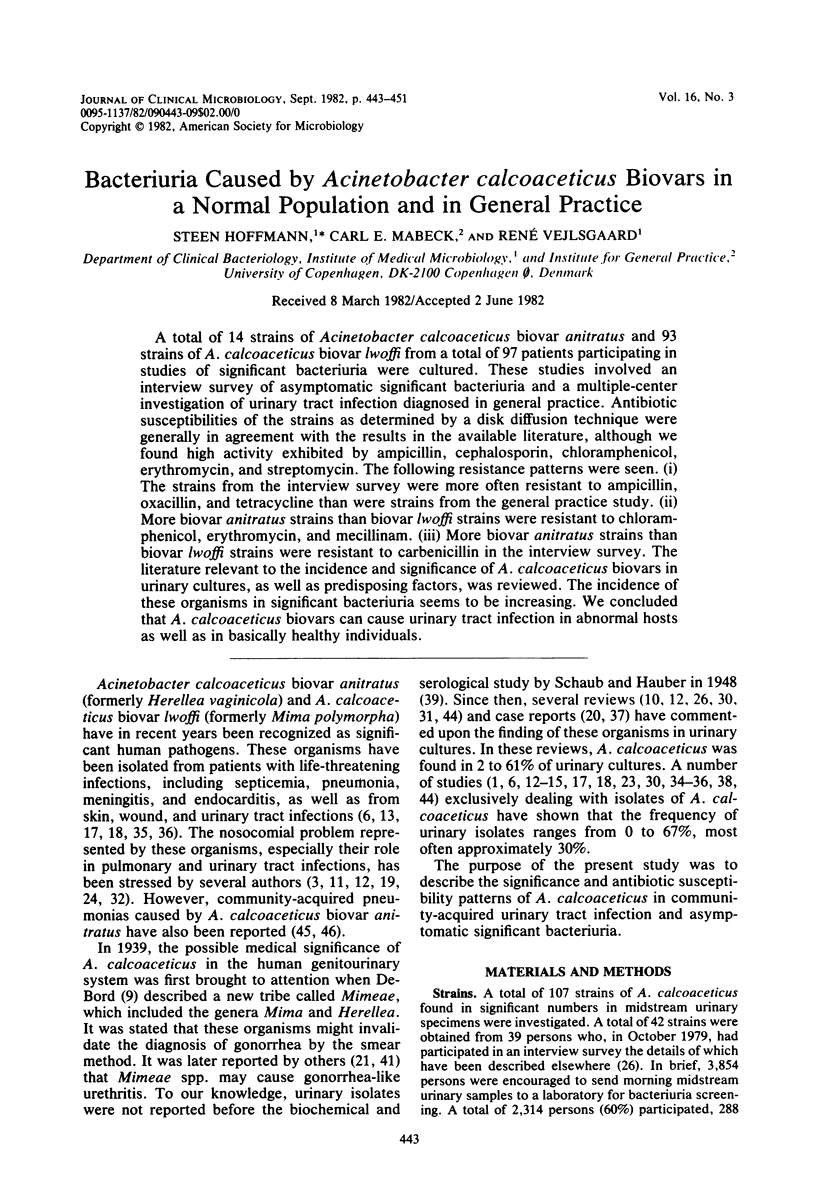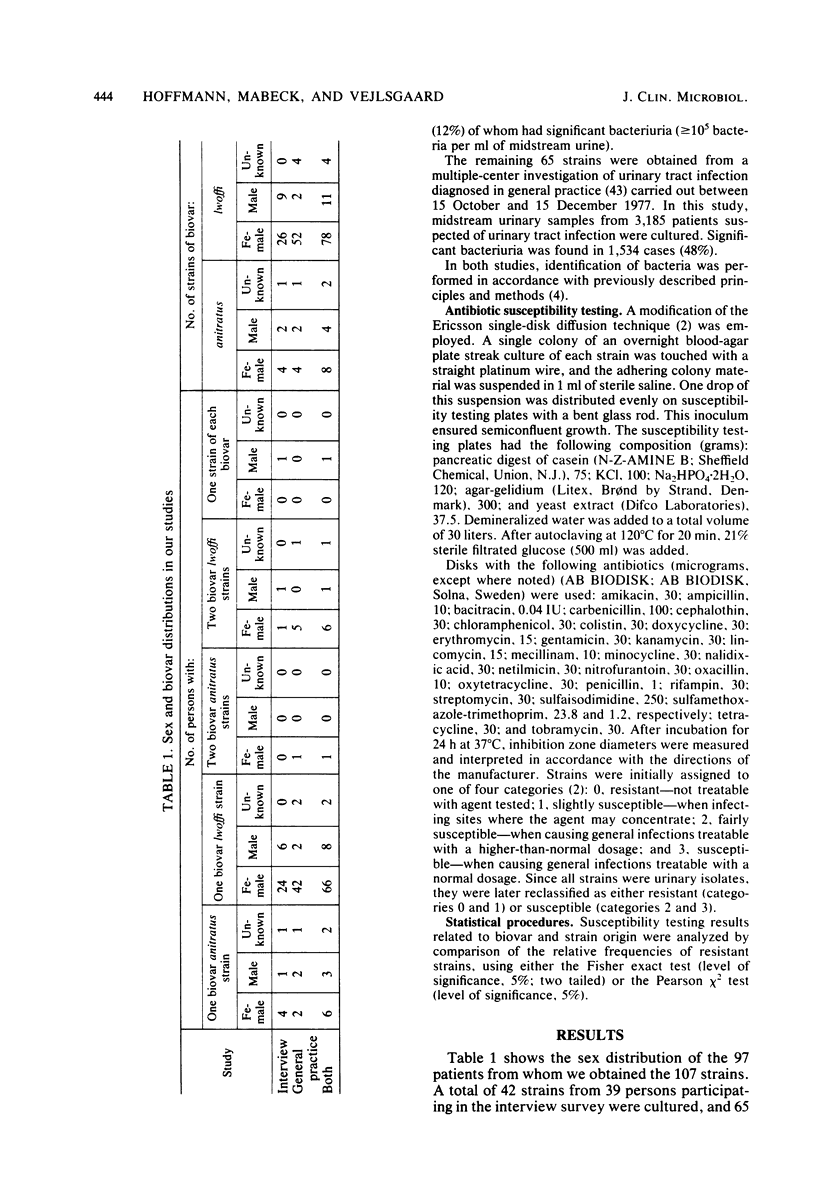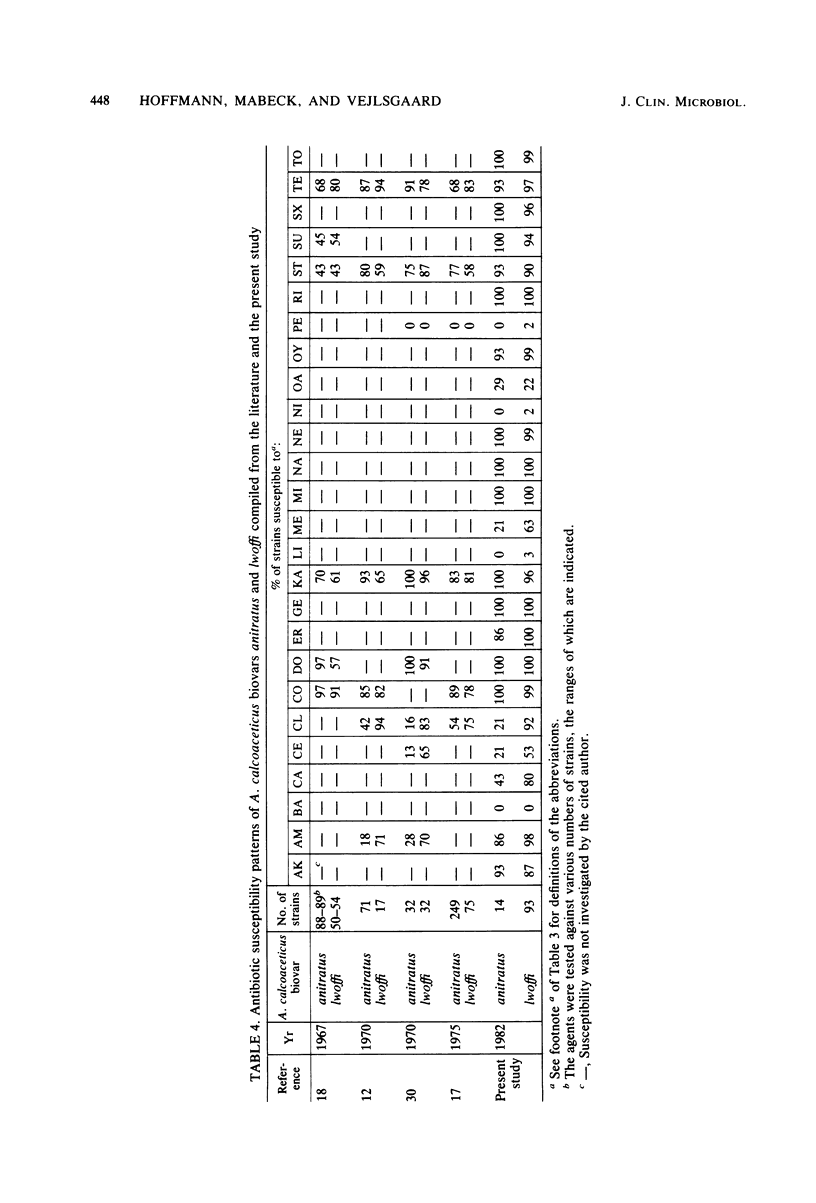Abstract
A total of 14 strains of Acinetobacter calcoaceticus biovar anitratus and 93 strains of A. calcoaceticus biovar lwoffi from a total of 97 patients participating in studies of significant bacteriuria were cultured. These studies involved an interview survey of asymptomatic significant bacteriuria and a multiple-center investigation of urinary tract infection diagnosed in general practice. Antibiotic susceptibilities of the strains as determined by a disk diffusion technique were generally in agreement with the results in the available literature, although we found high activity exhibited by ampicillin, cephalosporin, chloramphenicol, erythromycin, and streptomycin. The following resistance patterns were seen. (i) The strains from the interview survey were more often resistant to ampicillin, oxacillin, and tetracycline than were strains from the general practice study. (ii) More biovar anitratus strains than biovar lwoffi strains were resistant to chloramphenicol, erythromycin, and mecillinam. (iii) More biovar anitratus strains than biovar lwoffi strains were resistant to carbenicillin in the interview survey. The literature relevant to the incidence and significance of A. calcoaceticus biovars in urinary cultures, as well as predisposing factors, was reviewed. The incidence of these organisms in significant bacteriuria seems to be increasing. We concluded that A. calcoaceticus biovars can cause urinary tract infection in abnormal hosts as well as in basically healthy individuals.
Full text
PDF








Selected References
These references are in PubMed. This may not be the complete list of references from this article.
- BROOKE M. S. The occurrence of B5W (B. anitratum) strains in Denmark. Acta Pathol Microbiol Scand. 1951;28(4):338–342. doi: 10.1111/j.1699-0463.1951.tb03699.x. [DOI] [PubMed] [Google Scholar]
- Buxton A. E., Anderson R. L., Werdegar D., Atlas E. Nosocomial respiratory tract infection and colonization with Acinetobacter calcoaceticus. Epidemiologic characteristics. Am J Med. 1978 Sep;65(3):507–513. doi: 10.1016/0002-9343(78)90777-5. [DOI] [PubMed] [Google Scholar]
- Crues J. V., 3rd, Murray B. E., Moellering R. C., Jr In vitro activity of three tetracycline antibiotics against Acinetobacter calcoaceticus subsp. anitratus. Antimicrob Agents Chemother. 1979 Nov;16(5):690–692. doi: 10.1128/aac.16.5.690. [DOI] [PMC free article] [PubMed] [Google Scholar]
- DALY A. K., POSTIC B., KASS E. H. Infections due to organisms of the genus Herellea. B5W and B. anitratum. Arch Intern Med. 1962 Nov;110:580–591. doi: 10.1001/archinte.1962.03620230026006. [DOI] [PubMed] [Google Scholar]
- Deacon W. E. A Note on the Tribe Mimeae (De Bord). J Bacteriol. 1945 May;49(5):511–512. doi: 10.1128/jb.49.5.511-512.1945. [DOI] [PMC free article] [PubMed] [Google Scholar]
- Elston H. R., Hoffman K. C. Identification and clinical significance of Achromobacter (Herellea) anitratus in urinary tract infections. Am J Med Sci. 1966 Jan;251(1):75–80. doi: 10.1097/00000441-196601000-00013. [DOI] [PubMed] [Google Scholar]
- GARDNER D. L., PINES A., STEWART S. M. Fulminating and fatal pneumonia and septicaemia due to achromobacter antitratus. Br Med J. 1960 Apr 9;1(5179):1108–1109. doi: 10.1136/bmj.1.5179.1108. [DOI] [PMC free article] [PubMed] [Google Scholar]
- GRONROOS P. Occurrence of Bacterium anitratum in patients in a central hospital in Finland. Ann Med Exp Biol Fenn. 1960;38:1–8. [PubMed] [Google Scholar]
- Gardner P., Griffin W. B., Swartz M. N., Kunz L. J. Nonfermentative gram-negative bacilli of nosocomial interest. Am J Med. 1970 Jun;48(6):735–749. doi: 10.1016/s0002-9343(70)80009-2. [DOI] [PubMed] [Google Scholar]
- Glew R. H., Moellering R. C., Jr, Kunz L. J. Infections with Acinetobacter calcoaceticus (Herellea vaginicola): clinical and laboratory studies. Medicine (Baltimore) 1977 Mar;56(2):79–97. doi: 10.1097/00005792-197703000-00001. [DOI] [PubMed] [Google Scholar]
- Henriksen S. D. Moraxella, Acinetobacter, and the Mimeae. Bacteriol Rev. 1973 Dec;37(4):522–561. doi: 10.1128/br.37.4.522-561.1973. [DOI] [PMC free article] [PubMed] [Google Scholar]
- Inclan A. P., Massey L. C., Crook B. G., Bell J. S. Organisms of the tribe Mimeae: incidence of isolation and clinical correlation at the City of Memphis Hospitals. South Med J. 1965 Oct;58(10):1261–1266. [PubMed] [Google Scholar]
- Irving W. R., Jr, Herrick W. C. The bacteria Mima-herellea. Isolation and clinical significance in a general hospital. Am J Clin Pathol. 1967 Jun;47(6):729–733. doi: 10.1093/ajcp/47.6.729. [DOI] [PubMed] [Google Scholar]
- Irwin R. S., Demers R. R., Pratter M. R., Garrity F. L., Miner G., Pritchard A., Whitaker S. An outbreak of acinetobacter infection associated with the use of a ventilator spirometer. Respir Care. 1980 Feb;25(2):232–237. [PubMed] [Google Scholar]
- Kozub W. R., Bucolo S., Sami A. W., Chatman C. E., Pribor H. C., Amboy P. Gonorrhea-like urethritis due to Mima polymorpha var. oxidans. Patient summary and bacteriological study. Arch Intern Med. 1968 Dec;122(6):514–516. [PubMed] [Google Scholar]
- Kuck N. A. In vitro and in vivo activities of minocycline and other antibiotics against Acinetobacter (Herellea-Mima). Antimicrob Agents Chemother. 1976 Mar;9(3):493–497. doi: 10.1128/aac.9.3.493. [DOI] [PMC free article] [PubMed] [Google Scholar]
- LOTHE F., GRIFFIN E. BACTERIUM ANITRATUM AND MIMA POLYMORPHA INFECTION IN UGANDA. J Clin Pathol. 1965 May;18:301–306. doi: 10.1136/jcp.18.3.301. [DOI] [PMC free article] [PubMed] [Google Scholar]
- Lowes J. A., Smith J., Tabaqchali S., Shaw E. J. Outbreak of infection in a urological ward. Br Med J. 1980 Mar 8;280(6215):722–722. [PMC free article] [PubMed] [Google Scholar]
- Mabeck C. E. Brug af antibakterielle laegemidler i almen praksis. III. Behandling af patienter med urinvejsinfektion. Ugeskr Laeger. 1981 Mar 30;143(14):871–873. [PubMed] [Google Scholar]
- Mabeck C. E., Pedersen P. A., Vejlsgaard R. Befolkningens oplysninger og viden om urinvejsinfektioner. Ugeskr Laeger. 1982 May 10;144(19):1409–1411. [PubMed] [Google Scholar]
- Maderazo E. G., Quintiliani R., Tilton R. C., Bartlett R., Joyce N. C., Andriole V. T. Activity of minocycline against Acinetobacter calcoaceticus var. anitratus (syn. Herellea vaginicola) and Serratia marcescens. Antimicrob Agents Chemother. 1975 Jul;8(1):54–57. doi: 10.1128/aac.8.1.54. [DOI] [PMC free article] [PubMed] [Google Scholar]
- Montgomerie J. Z., Pickett M. J., Yoshimori R. N., Chow A. W., Guze L. B. Susceptibility of Acinetobacter calcoaceticus var. anitratus (Herellea vaginicola) to minocycline. Antimicrob Agents Chemother. 1976 Jul;10(1):102–105. doi: 10.1128/aac.10.1.102. [DOI] [PMC free article] [PubMed] [Google Scholar]
- Murray B. E., Moellering R. C., Jr Aminoglycoside-modifying enzymes among clinical isolates of Acinetobacter calcoaceticus subsp. anitratus (Herellea vaginicola): explanation for high-level aminoglycoside resistance. Antimicrob Agents Chemother. 1979 Feb;15(2):190–199. doi: 10.1128/aac.15.2.190. [DOI] [PMC free article] [PubMed] [Google Scholar]
- PHILPOT V. B., Jr The bacterial flora of urine specimens from normal adults. J Urol. 1956 Mar;75(3):562–568. doi: 10.1016/S0022-5347(17)66848-4. [DOI] [PubMed] [Google Scholar]
- Pedersen M. M., Marso E., Pickett M. J. Nonfermentative bacilli associated with man. 3. Pathogenicity and antibiotic susceptibility. Am J Clin Pathol. 1970 Aug;54(2):178–192. doi: 10.1093/ajcp/54.2.178. [DOI] [PubMed] [Google Scholar]
- REYNOLDS R. C., CLUFF L. E. Infection of man with Mimeae. Ann Intern Med. 1963 May;58:759–767. doi: 10.7326/0003-4819-58-5-759. [DOI] [PubMed] [Google Scholar]
- ROBINSON R. G., GARRISON R. G., BROWN R. W. EVALUATION OF THE CLINICAL SIGNIFICANCE OF THE GENUS HERELLEA. Ann Intern Med. 1964 Jan;60:19–27. doi: 10.7326/0003-4819-60-1-19. [DOI] [PubMed] [Google Scholar]
- ROCHA H., GUZE L. B. Infections due to Bacterium anitratum. AMA Arch Intern Med. 1957 Aug;100(2):272–276. doi: 10.1001/archinte.1957.00260080098019. [DOI] [PubMed] [Google Scholar]
- Ramphal R., Kluge R. M. Acinetobacter calcoaceticus variety anitratus: an increasing nosocomial problem. Am J Med Sci. 1979 Jan-Feb;277(1):57–66. doi: 10.1097/00000441-197901000-00007. [DOI] [PubMed] [Google Scholar]
- Retailliau H. F., Hightower A. W., Dixon R. E., Allen J. R. Acinetobacter calcoaceticus: a nosocomial pathogen with an unusual seasonal pattern. J Infect Dis. 1979 Mar;139(3):371–375. doi: 10.1093/infdis/139.3.371. [DOI] [PubMed] [Google Scholar]
- Rosenthal S. L., Freundlich L. F. The clinical significance of Acinetobacter species. Health Lab Sci. 1977 Jul;14(3):194–198. [PubMed] [Google Scholar]
- Schaub I. G., Hauber F. D. A Biochemical and Serological Study of a Group of Identical Unidentifiable Gram-negative Bacilli from Human Sources. J Bacteriol. 1948 Oct;56(4):379–385. doi: 10.1128/jb.56.4.379-385.1948. [DOI] [PMC free article] [PubMed] [Google Scholar]
- TAPLIN D., ZAIAS N. THE HUMAN SKIN AS A SOURCE OF MIMA-HERELLEA INFECTIONS. JAMA. 1963 Dec 7;186:952–955. doi: 10.1001/jama.1963.63710100030023a. [DOI] [PubMed] [Google Scholar]
- Thamsborg G. M., Balslev I., Mabeck C. E., Vejlsgaard R. Urinvejsinfektioner i almen praksis. I. Klinisk billede og bakterieflora. Ugeskr Laeger. 1980 Jun 23;142(26):1657–1660. [PubMed] [Google Scholar]
- Thong M. L. Acinetobacter anitratus infections in man. Aust N Z J Med. 1975 Oct;5(5):435–439. doi: 10.1111/j.1445-5994.1975.tb03053.x. [DOI] [PubMed] [Google Scholar]
- Wallace R. J., Jr, Awe R. J., Martin R. R. Bacteremic Acinetobacter Herellea pneumonia with survival: case report. Am Rev Respir Dis. 1976 May;113(5):695–699. doi: 10.1164/arrd.1976.113.5.695. [DOI] [PubMed] [Google Scholar]
- Wands J. R., Mann R. B., Jackson D., Butler T. Fatal community-acquired Herellea pneumonia in chronic renal disease. Case report. Am Rev Respir Dis. 1973 Oct;108(4):964–967. doi: 10.1164/arrd.1973.108.4.964. [DOI] [PubMed] [Google Scholar]


